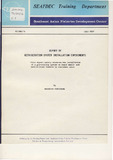| dc.description.abstract | As is well known in the ASEAN Region, the fishery resources in the coastal and offshore waters have a tendency to decline, with the increase of fishing intensity, though the actual situation of the coastal resources will vary for each country. On the other hand, the demand by both local and international markets for fish, both quantitatively and qualitatively, has been increasing, particularly the demand for high quality fish . It is therefore essential to maintain the high standard of freshness of the catch until it reaches the consumers.
There is a tendency to enlarge the size of fishing vessels in order to be able to increase the catch by going to distant fishing grounds where fish resources are less exploited. As the number of fishing days in a cruise will be expected to increase, it will be necessary to install sufficient refrigeration facilities to preserve the fish on board.
As the large-sized fishing vessels of 150-200 gross tons class have sufficient refrigeration facilities for preserving the fish on board, there would be no problem to maintain the freshness of fish until they reach the landing places.
As the small coastal fishing vessels of less than 10 gross tons have only one or one-half days of cruise, there would be few problems for preserving the freshness of fish by using the ice storage system.
However, the medium-sized fishing vessels of 10 to 40 gross tons, which are the major supply source of fish to the large fish markets in the region, do not have an adequate preserving facility to maintain the freshness of the fish on board.
In order to improve on the system for maintaining the freshness of the fish on board medium-sized Thai trawlers, I devised a plan during the last two years for introducing a type of refrigeration system, and
in 1986 conducted the experiment to collect data by using the M.V.PLALUNG which belongs to the SEAFDEC training Department.
Before explaining the idea of my experiment, its process and my evaluation at each step of the experiment for introducing a new type of refrigeration system, I would like to take this opportunity to express my sincere appreciation to Dr. Veravat Hongskul, Chief of the SEAFDEC Training Department, and to the Japan International Cooperation Agency for thir kind assistance in allowing me to conduct the experiment. | en |

